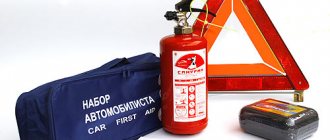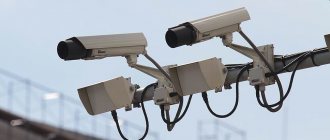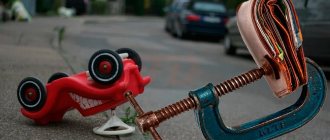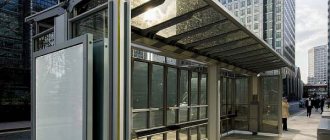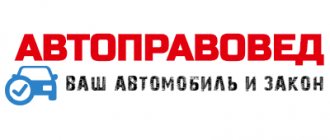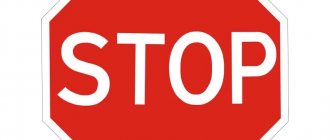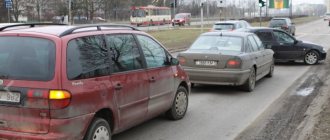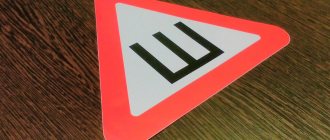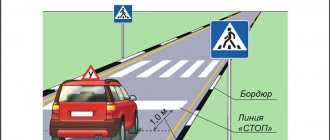| Question | Answer |
| What should a driver do in case of an accident, breakdown or other emergency stop on public roads? | Turn on the hazard warning lights and install an appropriate emergency stop sign. |
| In what cases is it necessary to install an emergency sign? | An emergency sign must be installed when: road accident; Forced stopping of the car in places where it is prohibited; Forced car stop in places of poor visibility. |
| What should be the distance from the warning triangle to the vehicle? | The distance to the vehicle depends on where it stops. In the city it should be equal to or more than 15 meters, outside the city - equal to or more than 30 meters. |
| What fine can be imposed on a driver who does not have a warning triangle? | The fine (both repeated and primary) is 500 rubles. |
| What geometric shape should the design of the emergency sign correspond to? | The design should have the shape of an isosceles triangle. |
| Which countries require vehicles to have emergency stop warning lights? | In all European countries except England, Holland, Germany, Malta and Sweden. |
| Under what conditions are car owners primarily required to carry reflective vests in certain European countries? | First of all, such vests are used in darkness and bad weather conditions. |
In the event of an emergency forced stop (in case of an accident, breakdown, etc.) on public roads, the driver must take the necessary measures to make the passage of other road users as safe as possible. Thus, he must highlight his vehicle with hazard warning lights and put up a warning triangle so that other drivers are notified in advance of an obstacle on the road and can reduce speed or make another maneuver.
A warning triangle must be used in all cases when the traffic situation requires it (see below), as defined in the seventh section of the Rules of the Road. The main purpose is to warn other drivers about an obstacle on the road so that they can make a timely maneuver, so the design must be aligned with the movement of the lane in which the car is stopped.
If the situation requires you to display an emergency stop sign, but the driver does not do this, administrative sanctions in the form of a fine may be applied to him (see below). A fine will be imposed even if the driver simply does not have a sign with him or it is faulty.
When to install
The structure must be installed in the following cases, in accordance with paragraph 7.2 of the traffic rules:
- In case of a traffic accident.
- When a vehicle is forced to stop in places where it is prohibited: in the middle of the road, at an intersection, etc.
- When a vehicle is forced to stop in places of poor visibility, due to which other road users cannot notice the vehicle in a timely manner: around a sharp turn, behind a hill, etc.
Also, the structure must be attached to the rear of the car when it is towed in the case when the hazard warning lights do not work, as defined in paragraph 7.3 of the traffic rules.
Driving schoolhome traffic rules online
We have launched free distance learning on Youtube. Subscribe to our channel and watch video lectures.
The rules prohibit operating a car unless it is equipped with three mandatory accessories: a first aid kit, a fire extinguisher and a warning triangle.
. All this can be purchased at retail stores and must be stored in an easily accessible place in the car.
An emergency stop sign is a red triangle, which, if necessary, the driver must place on the roadway from the direction of approaching traffic. The sign is clearly visible not only during the day, but also at night, as it has the ability to reflect the headlights falling on it. Even in the dark, other drivers will see it, understand in advance that there is danger ahead, reduce their speed and be ready to stop or go around you.
A few words about what hazard warning lights are.
Absolutely every car has such a key (or button) - if you press it, then all the direction indicators and two more repeaters on the side surfaces of the front wings begin to flash simultaneously. That is, as many as six orange lights flash on all sides of the car at once. The driver, turning on the hazard warning lights or using a warning triangle, seems to shout to other road users:
"I have a problem's! Be careful! Now, without meaning to, I pose a danger to everyone!”
This is something like a special language (let’s call it “emergency language”). This language has only a few words and you need to know them. Moreover, both the one who “screams” and those who hear this “scream” need to know them. Then you can not only see that something happened, but also understand what exactly happened. Either an accident has occurred, or one person is towing another, or children are being boarded on a bus intended for their organized transportation.
The hazard warning lights must be turned on:
– in case of a traffic accident;
– when forced to stop in places where stopping is prohibited;
– when towing (on a towed motor vehicle);
– when the driver is blinded by headlights;
– when boarding children in a vehicle with identification marks “Transportation of Children” and disembarking from it:
– the driver must turn on the hazard warning lights in other cases to warn road users about the danger that the vehicle may create.
A warning triangle must be displayed:
– in case of a traffic accident;
– when forced to stop in places where stopping is prohibited;
– when forced to stop in any place where a stationary vehicle cannot be seen in a timely manner by other drivers.
In case of a traffic accident.
In the event of an accident, the first thing to do is to immediately turn on the hazard warning lights. Then also immediately put up a warning triangle. And only after that - everything else.
When forced to stop in places where stopping is prohibited.
You already know how to behave during a forced stop - first of all, turn on the emergency lights and put up an emergency stop sign.
Moreover, if you happen to break down in a place where stopping is not prohibited, or you manage to roll the car to a place where stopping is not prohibited (for example, to the side of the road), then in this case the Rules do not oblige drivers to “shout” to everyone about their problems.
However, if you are going to repair it right on the road, then this is a different situation.
Now you are certainly creating a danger for yourself and for the movement of other vehicles. And, therefore, they must turn on the emergency lights and put up an emergency stop sign.
Rules. Section 7. Clause 7.2. Paragraph 3 .
This sign is installed at a distance that provides timely warning to other drivers of the danger in a particular situation. However, this distance must be at least 15 meters from the vehicle in populated areas and at least 30 meters outside populated areas.
Did you notice: The rules established only the lower limit ( at least
15 meters in populated areas
and
at least 30 meters on the road outside populated areas
). The Rules say nothing about “no more.” Drivers must determine the upper limit themselves, guided by safety considerations in each specific situation.
In all likelihood, something happened around the bend. And the driver put up a warning triangle, moving away from the scene of the incident much more than 30 meters.
And he did the right thing!
In this situation, this is exactly what you need to do!
When towing.
Everyone who has ever been towing or being towed has fully tasted all the “delights” of such a movement.
The distance between the cars is from 4 to 6 meters (this is the length of the tow rope), both are very limited in maneuvering, they can only accelerate slowly and brake only smoothly. In a word, it’s also “pleasure”.
In this situation, all you need is to competently “shout” to everyone that you are being towed - while the person being towed is moving, the hazard warning lights must be on.
Moreover, specifically for the towed one and only for the towed one!
What to do if the alarm system does not work?
Rules.
Section 7. Clause 7.3. If there is no or malfunction of the hazard warning lights on the towed motor vehicle, a warning triangle must be attached to its rear part.
Just try to make sure that the warning triangle does not limit your view and does not obscure the state registration plate of your car.
When the driver is blinded by headlights.
Night time. A road outside a populated area without artificial lighting. A car is driving towards you with its headlights on. Just imagine - you don’t see the road surface, you don’t see the markings, you don’t see the edge of the road, you don’t see that the road makes a turn. This is deadly!
The most correct thing now is to depict a forced stop. That is, of course, there is no need to put up a sign, just turn on the hazard warning lights and smoothly stop without changing lanes. I assure you, this is the most correct and safe decision. Moreover, the Rules require the same:
Rules.
Section 19. Clause 19.2. Paragraph 5. If blinded, the driver must turn on the hazard warning lights and, without changing lanes, reduce speed and stop.
Then, when the car that blinded you passes, start driving and, having accelerated to the average speed of the flow, turn off the emergency lights.
When boarding and disembarking children from a vehicle that has the “Transportation of Children” markings.
For the organized transportation of children, buses are specially hired, and these buses must have “Transportation of Children” identification signs on the front and rear.
Children are children. Getting carried away, they may forget that they are on the road. Therefore, every time children are boarded or disembarked, the driver of such a bus is required to turn on the hazard warning lights. This is also one of the words in the “emergency language”, and it is very important that drivers understand it correctly. That is, when driving around such a bus, you need to be extremely careful and take all precautions.
The driver must turn on the hazard warning lights in other cases to warn road users of the danger that the vehicle may pose.
Well, we have already considered one such case. This is when you decide to get repairs right on the road, and you are standing in a place where stopping is not prohibited.
Suppose this happens on the side of the road outside a populated area, that is, where stopping is not only allowed, but even prescribed by the Rules. You will now be walking around the car, opening and closing doors, hanging out under the hood, and perhaps even crawling under the car, leaving your feet on the roadway. And all this time cars will fly past. Of course, just because you turn on your hazard warning lights and put up a warning triangle, they won’t stop flying by, but drivers will be more attentive and, just in case, will increase the lateral interval towards you.
And another suitable case is when your vehicle has a malfunction that prohibits its operation. For example, the windshield was broken by a stone. Well, what to do now? In this case, the rules allow you to drive home or to the place of repair (do not abandon the car on the road). But with all necessary precautions!
That is, firstly, you will move in the far right lane. Secondly, you need to move at a low speed (and it won’t work at a high speed - the wind will blow in your face, carrying with it road dust and sand). And thirdly, during such (!) movement you are required to turn on the hazard warning lights.
The rules do not cover all such cases. According to the Rules, drivers must turn on the emergency lights whenever they, voluntarily or unwittingly, create a danger to traffic.
Distance from emergency sign to car
The distance to the vehicle depends on where the vehicle stops. In a populated area, this distance cannot be less than 15 meters, outside the city limits - at least 30 meters, as determined by clause 7.2 of the traffic rules. However, the same paragraph indicated that the distance must be sufficient so that other road users are promptly warned of the danger and can make the necessary maneuver. So, depending on the situation, the following rules are used:
- If a vehicle is stopped just after a sharp curve, the sign must be placed in front of it.
- If the vehicle has stopped behind a hillock, the sign is placed in front of it.
- If the stop occurs on a highway, an emergency sign is posted at a distance of 50–100 meters so that other drivers have time to slow down if necessary.
- If an accident occurs at an intersection, the driver places a sign in the direction of the busiest traffic.
Fine for not having a warning triangle
If the driver does not have a stop sign with him, he can be fined 500 rubles, according to Article 12.5 of the Code of Administrative Offenses, if the traffic police inspector detects this violation when stopping the vehicle. The fine is 500 rubles, regardless of whether it is repeated or primary.
If a driver does not display an emergency sign during an accident or displays it incorrectly (in the wrong lane or at the wrong distance), the traffic police inspector may fine him 1,000 rubles, according to Article 12.27 of the Administrative Code. The amount of the fine does not depend on the number of previous violations. The same fine applies for not turning on the hazard warning lights (provided that they were not damaged).
Remember
- The fine for not displaying a warning triangle is 1,000 rubles.
- If, when checking the trunk, the inspector does not find a warning triangle there, he will issue a fine of 500 rubles. If this is the first time this has happened to the driver, the inspector may limit himself to a warning.
- Only an inspector can record a violation of a warning triangle. Cameras don't see this yet.
- The most convenient way to check and pay a fine is on the Traffic Police Fines website.
All articles by the author: Evgeniy Lesnov
How to choose
The design must comply with the requirements of GOST R 41.27-2001, which states the following:
- The design is in the shape of an isosceles triangle.
- Each side of the triangle cannot be less than 50 centimeters.
- The material must be bright: red or orange.
- A reflective element giving a signal must be glued to the edge of each side. Width at least 5 centimeters.
In addition to the above, attention should be paid to the following nuances:
- Convenient and reliable legs for installing the structure on the road.
- The presence of additional reflective (fluorescent) elements. To make the sign more visible in the dark, another triangle is placed inside, entirely consisting of reflective materials.
- Material of manufacture. Plastic breaks easily and is very light, which is why the structure can fall in strong winds. Iron signs are more expensive, but more reliable.
Requirements in Europe
The requirement for emergency stop warnings in a vehicle is imposed in all European countries except England, Germany, Holland, Malta and Sweden.
In some countries, such as Serbia, Croatia, Bosnia, Macedonia, Slovenia and Montenegro, the driver must have 2 signs at once if a trailer is attached to their vehicle. If the vehicle is moving without a trailer, there can only be one sign and it is placed at the rear of the vehicle.
In Cyprus, as well as in Romania and Turkey, drivers are required to carry two signs even if they do not have a trailer.
And in Spain, the obligation to carry 2 signs is assigned only to citizens of their own country. Foreigners are allowed to carry one badge, but are advised to purchase a second one. In all four countries, when a vehicle is forced to stop, the structure must be positioned in both directions in the lane where the car is located. If this is not done, the driver will be fined accordingly, including in Spain, where administrative sanctions can also be applied to foreigners who, by default, are not required to carry 2 signs.
Also, in some European countries, motorists are required to carry reflective vests. First of all, such vests should be used in the dark and in bad weather. In some countries, it is mandatory to wear it every time you get out of the car when stopping on the road (not in a parking lot).
Traffic lights in traffic rules - what is more important, the traffic light or the markings?
In what cases is a fine issued?
No warning sign in the car. If there is no warning triangle in the car, the driver will be issued a monetary sanction - a fine. This may be discovered by an inspector when inspecting the trunk.
This is not the fine that is issued for the absence of a sign during an accident. Here the point is in the list of requirements for the car, if not met, the car cannot go on the track. There is an item on this list that talks about a missing warning triangle. This means that you cannot go on the road without this obligatory item.
Incorrect placement of the emergency marker. If the sign is placed unacceptably close to the car, passing drivers may not have time to react and will crash into a standing car if there is insufficient clarity.
Non-compliance of the emergency sign with the requirements established by law. There will be no fine for non-compliance of the sign with the guest. Traffic regulations refer to GOST 1997, but it is outdated. And violating this prohibition is difficult to imagine: the cost of the sign is about 150 rubles, no one will make it themselves.
An undisclosed warning sign in the event of an accident. If the drivers who caused the accident did not put up an emergency stop sign, the traffic police officer will issue a report on each person, and then a fine.
